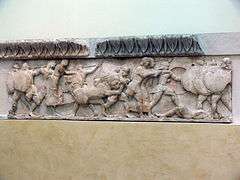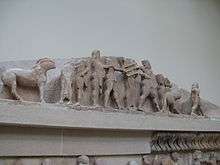Siphnian Treasury
| Siphnian Treasury | |
|---|---|
 North frieze, showing the Gigantomachy | |
| General information | |
| Type | Treasury |
| Architectural style | Ionic |
| Location | Delphi, Greece |
| Owner | Delphi Archaeological Museum |
The Siphnian Treasury was a building at the Ancient Greek cult centre of Delphi, erected to host the offerings of the polis, or city-state, of Siphnos. It was one of a number of treasuries lining the "Sacred Way", the processional route through the Sanctuary of Apollo, erected to win the favor of the gods and increase the prestige of the donor polis. It was one of the earlier surviving buildings of this type, and its date remains a matter for debate, with the most plausible date being around 525 BC.[1] Until recently it was often confused or conflated with the neighbouring Cnidian Treasury, a similar but less elaborate building, as the remains of the two had become mixed together and earlier theoretical reconstructions used parts of both.[2]
The people of Siphnos had gained enormous wealth from their silver and gold mines in the Archaic period (Herodotus III.57) and used the tithe of their income to erect the treasury, the first religious structure made entirely out of marble. The building was used to house many lavish votive offerings given to the priests to be offered to Apollo.
The Treasury fell to ruins over the centuries, although it stood for much longer than many other monuments, probably due to its decoration which was venerated by the following generations. Currently, the sculpture and a reconstruction of the Treasury are to be seen in the Delphi Archaeological Museum.
Dating of founding
The only classical source to provide information on this building is Herodotus (3:57-8). If Herodotus is to be deemed a reliable source, this would be sufficient for verifying the date. In his account Herodotus states that the Siphnians had recently founded a temple at Delphi when a group of Samians arrived asking for support against the tyrannical Polycrates. In respect to this, both Herodotus and Thucydides state that Polykrates ruled during the reign of the Persian king Kambyses (c. 529-522 BC).[3] This would thus date the monument at about 525 BC.[4] one source considers the date of construction as more likely some time absolutely limited to after 480 BC (Whitley).[5]
Design and Decoration
The croquis of the treasury develops in two parts; a pronaos, or porch, and a cella, or enclosure. The pronaos is distyle in antis, i.e., the side walls extend to the front of the porch, and the pediment is supported by two caryatids instead of plain pilasters. Below the pediment runs a continuous frieze. The building is 8.27 metres long and 6.09 wide.[6][7][8]
The pediment of the treasury shows the incident of Herakles stealing Apollo’s tripod which was strongly associated with his oracular inspiration. The treasury was also one of the first Greek buildings to utilize falling and reclining figures to fill the corners of the pediment. The sculptural friezes that run around the building depict various scenes from Greek Mythology, particularly related to the Trojan War. The Eastern side depicts the gods seated and watching the Greeks raid the city of Troy as if at an assembly, trying to decide upon the fate of the two sides. To the right one sees Athena as leader of the pro-Greek faction. To the left are seated the gods protecting the Trojans: Apollo, Ares, Aphrodite and Artemis. In the middle sits Zeus on his throne. At another part of this frieze one discerns a scene of dual battle around the body of a dead warrior with the Achaeans standing to the left and the Trojans standing to the right. The West side shows the story of the Judgment of Paris, depicting three chariots groups (each attributed to Athena, Aphrodite, and Hera). The north side displays the Gigantomachy.The southern frieze is the most worn out; one discerns clearly the traces of beautifully carved horses; it has been suggested that the scene depicts the abduction of Hippodameia by Pelops or of the Leucippides by the Dioscuri. The reliefs were painted over with vivid shades of green, blue, red and gold, thus creating a unique sense of polychromy.
The façade
On the façade of the temple-like ionic Treasury of the Siphnians there are two kores (maidens), instead of columns, between the pilasters, which constitute beautiful supports for the Ionic architrave. This type of opulent decoration featuring female figures full of motion and plasticity rather than the usual abstract architectural shapes of temples, foreshadows the rare beauty of the Caryatids erected subsequently at the Erechtheion in the Acropolis of Athens.
The east pediment

It is the only surviving pediment of the Siphnian Treasury and depicts a famous Delphic theme. In the center of the pediment there is Zeus (other sources claim it is Athena or Hermes), on the left Apollo and on the right Hercules. The two young gods are competing for the Delphic tripod and Zeus in the middle is trying to separate them. The sculpture shows the anger of Hercules because Pythia refused to give him an oracle, since he had not been cleansed from the murder of Iphitus. An outraged Hercules has already managed to seize the sacred tripod and Apollo is trying to pull it away from him.
The east frieze
The east side of the pediment depicts a scene from the Assembly of the Gods during the Trojan war, where the gods are discussing the issue with lively gestures like they are arguing. To the right we see Athena as the head of the gods who side with the Greeks. On the left we see the gods who protect and defend the Trojans: Apollo, Ares, Aphrodite and Artemis. In the middle we see Zeus in a lavish throne. At another part of the pediment we see a scene from the Trojan war: the scene is a duel over the dead body of a warrior, where the two adversaries are flanked by the heroes of the Achaeans on the right and those of the Trojans respectively on the left. The figure of old Nestor is encouraging the Greeks.
The north frieze
The theme on the north frieze is the Battle of the Giants (Gigantomachy), namely the battle of the sons of the Earth, the Giants, with the Olympian gods for power. It is a widespread myth about the conflict between the old and the new world order, depicted very frequently in ancient Greek art. It symbolizes the triumph of order and civilization over savagery, barbarism and anarchy. On one side are the Giants. Heavily armed with helmets, shields, breastplates and greaves, they are attacking the gods from the right with spears, swords and stones. On the opposite side are the gods. First Hephaestus stands out with his short chiton, standing in front of his bellows. He is followed by Demetra, then Heracles wearing his lion skin and Themis on her chariot drawn by lions. A pair of gods who are shooting their arrows against the Giants must be Artemis and Apollo. They are followed by the other gods, but these sculptures do not survive in good condition.
This side of the frieze could be seen from the sacred way, as the pilgrims ascended towards the Oracle. This way they had the opportunity to admire the scene of Gigantomachy, which transforms through the artistic relief into a narrative, unfolding in multiple levels, which nevertheless maintains its visibility, consistency and figurative nature despite the interwoven figures and the various action scenes.
The west frieze
Unfortunately, only a few relief figures have survived on the west frieze. The theme portrayed here is probably the Judgment of Paris when selecting the most beautiful goddess from among Aphrodite, Hera and Athena. The first goddess coming to be judged is Athena, standing proud on the winged chariot with Hermes as her charioteer. Elsewhere, we see Aphrodite descending from her chariot, with a particular grace, a smirk and the flair of the winner. In the section of the frieze that has been lost we can imagine Hera mounting her chariot to depart angry at her rejection.
The south frieze
Significant portions of the south frieze are missing, so we can only imagine the theme it portrayed. It is probably the also popular theme of abducting women. However, the surviving fragments are the relief, well-sculpted horses portrayed full of energy, which prove the mastery of the artist. As for the craftsmen who worked on the frieze the opinions of researchers and scholars who studied it are conflicting. Initially it was believed that it was the work of two different artistic workshops. Gradually, however, this view has been abandoned. It is most likely that there were two main sculptors, around whom two groups of craftsmen worked together. The artist of the north and east sides of the frieze seems more progressive, with his depictions being more active, imaginative and vibrant. In contrast, the artist of south and west side of the frieze insisted on more conservative options, without the bold inspiration and craftsmanship of the first, but with a strong painter-like character and an ionic 'color'.[9][10][11]
The oracle
... When the Prytanies' seat shines white in the island of Siphnos,White-browed all the forum – need then of a true seer's wisdom-Danger will threat from a wooden boat, and a herald in scarlet ...
See also
References
- ↑ Bommelaer, J.-F., Laroche, D., Guide de Delphes: le Site, Paris 1991
- ↑
- ↑ JM Hall - Artifact and Artifice: Classical Archaeology and the Ancient Historian (p.48) University of Chicago Press, 10 Jan 2014 ISBN 022608096X [Retrieved 2015-3-19]
- ↑ J K Darling -Architecture of Greece Greenwood Publishing Group, 2004 ISBN 0313321523 Retrieved 2012-06-16
- ↑ J Whitley – The Archaeology of Ancient Greece Cambridge University Press, 4 Oct 2001 ISBN 0521627338 Retrieved 2012-06-25
- ↑ J K Darling – Retrieved 2012-06-16
- ↑ University of North Carolina – Length Converter – Retrieved 2012-06-16
- ↑ University of Oxford Classical Art Research Centre & The Beazley Archive showing reconstructed drawing – Retrieved 2012-06-16
- ↑ Υπουργείο Πολιτισμού και Αθλητισμού: Μόνιμη Έκθεση Αρχαιολογικού Μουσείου Δελφών - Ζωφόρος του θησαυρού των Σιφνίων.
- ↑ Βαγγέλη Πεντάζου - Μαρίας Σαρλά, Δελφοί, Β. Γιαννίκος - Β. Καλδής Ο.Ε., 1984, 42.
- ↑ Ροζίνα Κολώνια, Το Αρχαιολογικό Μουσείο Δελφών, Αθήνα, Υπουργείου Πολιτισμού – Ταμείο Αρχαιολογικών Πόρων και Απαλλοτριώσεων, 2009, 29 – 35.
- ↑ Herodotus – The history of Herodotus: A new English version, ed. with copious notes and appendices, illustrating the history and geography of Herodotus, from the most recent sources of information; and embodying the chief results, historical and ethnographical, which have been obtained in the progress of cuneiform and hieroglyphical discovery, Volume 2 from (...and, G Rawlinson (The Histories) Retrieved 2012-06-16
Online Sources
- Hendrix, Andrea. "Siphnian Treasury". Coastal Carolina University. Retrieved 2009-04-19.
- "Siphnian Treasury, Delphi Museum". Ancient Greece.org. Retrieved 2009-04-19.
External links
| Wikimedia Commons has media related to Treasury of the Siphnians. |
- Michael Scott. "Delphi: The Bellybutton of the Ancient World". 26:06 minutes in. BBC 4. Retrieved 23 Nov 201. Check date values in:
|access-date=(help); Missing or empty|series=(help) - The Siphnian Treasury: The North side of the frieze (The Gigantomachy - Hall V)
Images
Coordinates: 38°28′54″N 22°30′05″E / 38.4816°N 22.5014°E